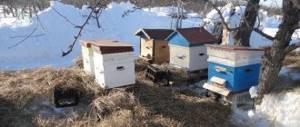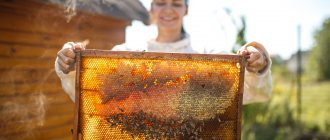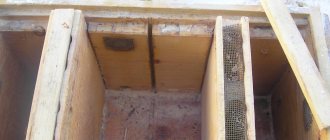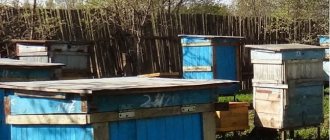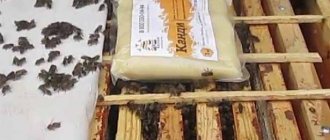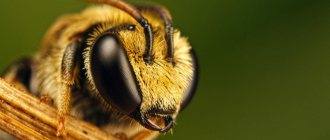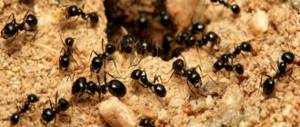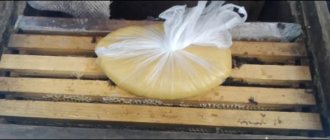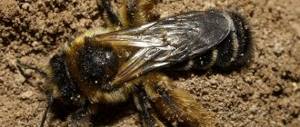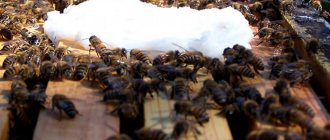Why doesn't a bee hibernate?
The family prepares for winter throughout the active spring-summer season, with the exception of the breeding season. Bees stock up on honey and raise a large generation of workers. They do not hibernate like other insects because they are not adapted to storing nutrients in their bodies. Individually, individuals cannot withstand the cold. Before wintering, bees gather in a group in the form of an ellipsoid. Inside it they sit more freely and can move around. Due to the movement in the center of the club, heat is generated up to 25-30 degrees. In the outer layer, the bees, pressing against each other, form a dense shell 3 to 7 cm thick with a temperature of about +15 degrees. Gradually they change places - from the center they fall into the shell and vice versa. By being in relatively active motion and feeding on honey from sealed frames, gathering in a club for warmth, they preserve their lives. Wintering bees in omshanik makes this difficult period easier for them.
How do bees winter?
How bees prepare and winter in the hive - an event that affects the strength, mobility, and health of the bee family when summer comes. Taking care of this in the apiary is in the hands of the beekeeper. Preparation begins with removing excess honeycomb and part of the honey mass. Start of work - October or November. Then a nest is formed with an empty middle, where the insects spend the winter.
The following signs are characteristic of a tangle created by insects:
- independent preparation (sealing) of food reserves by individuals - for their own convenience;
- bed (wintering place) – in the center of the hive, food is usually placed on top;
- the shape of the ball is a dense ball of sedentary insects;
- the purpose of collecting bees is to warm each other, the space in the house, maintaining the temperature at a constant level;
- an additional advantage of the coil is energy savings due to the creation of general heat exchange;
- mandatory contact of the upper part of the club with the feed supply;
- internal movements of individuals for the purpose of food.
There is a direct relationship between temperature and the activity of the bee ball. The lower the degrees in the hive, the denser the ball of insects. This helps reduce feed costs and energy waste. If the temperature rises, the ball disperses and the individuals become mobile.
Wintering bees in the wild
Wintering bees, carried out in the wild under the snow, requires experience and skills from the beekeeper. The factor on which this method depends is the climate of the area where the farm is located. The warm conditions of the southern regions do not provide special insulation for hives, unlike the northern latitudes.
Work plan:
- installation of protection from wind gusts (trees, fences, roofing felt);
- eliminating gaps in the structure;
- insulation of side walls, bottom of hives;
- covering the entrances with shields;
- covering roofs with snow.
The advantage of overwintering insects in the wild is the production of strong individuals for the summer season, adapted to difficult conditions. This allows the first flight to be carried out in early spring.
It is important to know that bees, when outdoors, eat more food than insects wintering in warm conditions.
Wintering of bees in omshanik
Overwintering insects in a cold room is a common method among beekeepers. Suitable buildings are above ground or underground buildings. In the absence of omshanik, insects are placed in a barn, greenhouse or cellar.
Conditions that are required to maintain and preserve the life of bee colonies when wintering indoors:
- insulation using wood, dry grass or clay;
- ventilation equipment for the passage of fresh air;
- tidying up the floors and walls to preserve heat;
- preparing the premises from the inside - whitewashing, repairs, drying, getting rid of pests, installing protection against rodents;
- temperature retention – from +6 to -4 degrees.
When cold weather sets in, bee houses with closed entrances are brought into the building. After the insects have calmed down (after 2–3 hours), the entrances are opened. In the first days, the room is intensively ventilated to remove condensation. Heating is not provided for Omsk dwellers, since the crowded hives generate the necessary heat.
The hum can be used to assess the adaptation of bees to new conditions. If the insects behave quietly, then the preparation and arrangement of the room were carried out correctly. When in doubt, it is better to leave the room slightly cool than overheated.
Features of winter behavior
Bees place food supplies at the top of the hive, closer to the back wall of the nesting box.
Below, opposite the entrance, they raise brood. Here they form into a club, which they form even at above-zero temperatures: in weak families - at +13 degrees, in strong families - at +8. The top half of the club is always placed on a significant area of the sealed frames. The bees warm the honeycombs with their warmth, the wax on their lids melts, and some of the cells are unsealed. Water vapor from the air penetrates them and dilutes the honey on which the bees feed. The club gradually moves upward along the honeycombs, heading towards the back wall of the hive. If there is enough honey within the frames, the bees calmly move along the spaces between the frames.
At the beginning of wintering, the required temperature in the club is maintained by heat from the bees during their life activities. When it gets colder, the club shrinks. Bees occupy interframe spaces and free honeycomb cells. To keep the club warm, they begin to eat more food.
When it is completely eaten, the bees are forced to move to neighboring frames. But they can make such a transition only at a sufficiently high temperature in the hive. If the outside temperature is less than zero, then the club is not able to move. The bees are showing concern. The club may split into two, resulting in the death of one or both halves.
Feed supply
Wintering bees in omshanik reduces honey consumption. Individuals united in a club slow down the rhythm of life. Metabolic processes in their bodies are less intense. Bees in a club need 20 times less food than bees separated for the same time. In the first month or two of wintering, they eat up to 700 g of honey in 30 days. By the end of the period, the monthly consumption is at least 1.2 kg. If the overwintering of bees in the moshannik was problem-free, and by spring brood appears in the hive, then the volume of food doubles.
Leave a frame containing at least 2 kg of honey and there are free cells in which the bees of the wintering club will be placed. Then it will remain dense, and it will be easier for the bees to maintain the temperature while eating less food. In addition to honey (carbohydrates, microelements), at least 2 frames of beebread (protein food) are stored for each family. It is necessary for feeding the brood in the spring. The cells with beebread must be preserved - filled with honey, sealed with a wax lid, otherwise the bread will mold and spoil.
What is omshanik
Omshanik is a room for keeping bees in winter.
Some beekeeping methods allow you to leave hives outside (for example, the Tsebro method, etc.). But beekeepers who use traditional methods in their practice prefer to use an insulated room. In which the bees tolerate the harsh Russian winters well. Omshanik protects the “houses” with bees not only from low temperatures, but more importantly from gusts of wind and street noise. Which also causes great discomfort to these working insects.
The presence of a special room for wintering bees helps to save time on insulating hives, reduce food consumption by bees, reduce the percentage of deaths of bees in individual colonies and colonies as a whole, and at the same time significantly extend the life of the hives.
Shelter for bee colonies
Omshanik is a specially equipped room, since during wintering insects suffer not so much from low temperatures as from poor ventilation. Not only the apiaries of the northern regions need such protection, but also the heat-loving breeds of the middle zone: Carpathian, steppe-Ukrainian, yellow, gray Caucasian. But owners of the Central Russian breed can rest easy: the insects are distinguished not only by their aggressive disposition, but also by their extraordinary winter hardiness.
The use of omshanik makes wintering easier and allows the beekeeper to sleep peacefully; its undoubted advantages include:
- Creating additional protection from frost, gusts of wind, moisture, as well as sudden changes in t. In addition, omshanik also protects from noise, creating maximum comfort for bee colonies to rest;
- The longer life of the hives is at least half, since the cold period lasts six months, and in omshanik the bee houses are not exposed to moisture, wind and weather changes;
- In a winter hut for bees, little workers do not need to spend additional effort on heating the house, so they spend less food. In addition to saving honey, this circumstance has another positive aspect: insects fill their intestines less and, in the event of a prolonged spring, can wait for warmth and avoid death during forced flight.
Important! An important advantage of omshaniks is the simplicity of their design and the ability to build a room with your own hands. Almost every experienced beekeeper is a “hands-on” person, so building a winter hut will not be difficult for him.
Preparing honeycombs
For a safe wintering, be careful when preparing forage combs.
Beekeeping for beginners can sometimes be quite a challenging endeavor, so take it as seriously as possible. The honeycombs are harvested in the first half of the season, and the order of installation of frames for food depends on the system (design) of the hive. Let’s immediately make a reservation that the honeycombs are neither new nor old, but “used” - light brown. In double-body honeycombs, before honey collection, combs with printed brood are placed in the center of the 2nd body. Of the multi-body honeycombs, such honeycombs are placed in the center of the top one. The removed frames are not pumped out - they contain food for the winter. In the beds in front of the main honey collection, combs with printed and open brood are placed side by side in the center, moving the light and black ones to the edge of the nest. In extension hives, 4-6 nesting frames are placed in the center of two extensions, and half-frames are placed along the edges. The bees work first on the honeycombs in the center. As soon as the nests are half sealed, they are taken from the hive, but the honey is not pumped out - this is winter food.
For reference: a honeycomb frame 43.5 x 30 cm holds 4 kg of honey, 43.5 x 23 cm - 3 kg, provided the cells are filled on both sides.
The right honey
The manual “Beekeeping for Beginners” draws special attention to the fact that not all honey is suitable for winter food.
To avoid honeydew toxicosis, for wintering bee colonies it is necessary to leave frames with honey without honeydew, collected in the first half of the honey collection. If a family overwinters on honeydew honey, then some of its members do not survive until spring - they begin to have diarrhea. Those who survive soil the nest with feces, which threatens with a dangerous parasitic disease - nosematosis. Rapidly crystallizing honey collected from willow, sunflower, sainfoin, sow thistle, and cruciferous plants (rapeseed) is not suitable for wintering. It cannot be liquefied. Bees overwintering with such honey become restless from thirst. The family weakens or dies from starvation with a supply of crystallized honey.
When preparing food, light brown honeycombs are used, in which several generations have been bred. They are less thermally conductive than light ones, retain heat in the nest better, and the queen lays eggs in them more readily in the spring. In old black honeycombs with nuclei of honey crystals remaining in them, fresh honey quickly hardens. Wintering will be unfavorable, because bees need liquid honey. Light honeycombs, in which there have not yet been broods of bees, are cold, the queen begins to lay eggs in them late, and the development of brood in them is delayed in the spring.
Omshanik for bees
The site for construction is chosen on a dry area (groundwater depth no closer than 1 m from the floor), on a slight slope (for drainage of melt and rainwater), with protection from winds. Omshanik is made inaccessible to mice that destroy hives, impervious to light and noise that disturbs bees.
Depending on the local conditions, buildings can be above-ground, underground or semi-underground. The most common are underground, buried to the height of the walls in the ground. In winter they will have an even temperature; in spring it will remain lower, which is important for the successful completion of wintering. The walls of the omshanik are made of brick or rubble; the wood is quickly affected by fungus.
Disadvantage of terrestrial winter huts: the walls are excessively cooled in winter, and under the spring sun they overheat, when it is too early for the bee to stop hibernating. In an above-ground room, a thermostat is needed for the omshanik - it will maintain the set temperature.
In semi-underground walls, they are buried half their height into the ground. Such omshaniks are usually built on the slope of a mountain.
Omshanik for bees consists of walls, floor, ceiling, roof, supply and exhaust ventilation. Inside they make racks for hives. The door opens inward, it is insulated with felt, and covered with roofing iron from the street.
The size of the winter hive determines the type and number of hives. The height from floor to ceiling is 2.5-3 m. The hives are placed on racks or one on top of another. Single-walled occupies 0.6 square meters. m area. Double-walled and bed hive - 0.7-0.9 sq. m. The distance from the walls to the hives is 10 cm, between rows is 90 cm.
Types of omshaniks
Beekeepers distinguish 3 types of buildings for wintering bees. Each of them has its own advantages and disadvantages.
Overhead
The simplest type. A room of the required area (according to the number of hives) is built on the soil surface from wood material. The walls of the winter hut should be double. Insulation (for example, expanded clay) is poured between the boards. It is important to choose the right place to install the structure. It must be protected from the wind.
Semi-underground
The semi-underground type is suitable for areas where groundwater comes close to the soil surface. The advantage of a semi-basement dwelling is the stability of the temperature, but the room quickly gains moisture. Because The building is half underground; small windows can be made for lighting.
Underground
Among all types of winter huts, the underground structure is the most popular among beekeepers. The roof of the structure is located at surface level. In such shelters, optimal conditions are created for wintering insects: air temperature and humidity are maintained, and the building is reliably protected from the wind. The only drawback is the laboriousness of the construction process.
Ventilation and temperature in omshanik
Humidity and wintering temperature of bees must be maintained at a constant level.
Allowable fluctuations of the latter are from -2 to +4 degrees, but the optimal one is from 0 to +2. When it's cold, bees eat more food, and their intestines become full of feces and diarrhea begins. Excess heat makes them extremely anxious. A relative humidity of 75-85% will be favorable. A higher one will cause dampness in the omshanik and the hives, while an excessive one will dilute the honey, causing it to sour. When bees eat sour honey, they develop diarrhea, become weak and die. Low humidity is not enough to liquefy the honey, it crystallizes, and the bees die from thirst and hunger.
Supply and exhaust ventilation is needed to regulate humidity and temperature in the garden. Fresh air enters through pipes under the floor, warm air with water vapor is drawn out by a pipe on the ceiling and discharged outside under the roof. The supply and exhaust are adjusted using valves. A family needs a hole with a cross-section of 8 square meters. cm. From this data the cross-sectional area of the pipes is calculated. If necessary, several of them are arranged.
Wintering conditions for bees
In order for the bee family to survive the winter safely, the winter hut must be maintained at an optimal temperature. As we have already said, the temperature should not exceed 6 degrees. The minimum threshold is 0 degrees.
Another important factor is humidity, which should not exceed 85%. But even with low humidity, bees will not be able to overwinter normally. In such conditions, honey quickly crystallizes and insects may die from lack of moisture. Therefore, it is important to comply with all the above conditions so that your apiary prospers.
A little advice: you need to start preparing the omshanik in the summer so that the cold does not take your apiary by surprise.
Moving to a “winter apartment”
In the summer, the omshanik is thoroughly dried, the floor is covered with dry sand, the walls and ceiling are whitewashed. Don't rush into moving the hives. In autumn there are warm days for bees to fly around. When to bring bees in for the winter? Usually in mid-November in the northern and central regions, in early December in the southern.
It is acceptable for bees to winter in a barn if its walls are insulated, the walls of the hives are covered with reed mats, and silence and darkness are ensured. Construction of a real omshanik is an expensive and labor-intensive undertaking. Wintering bees in a barn is more reliable than in an open space exposed to winds and snowfall. The bee is not afraid of the cold, but of hunger, dampness and drafts, and the beekeeper is afraid of thieves if the beekeeper is far from home. The features of successfully wintering an apiary in a barn are different than wintering bees in an omshanik.
